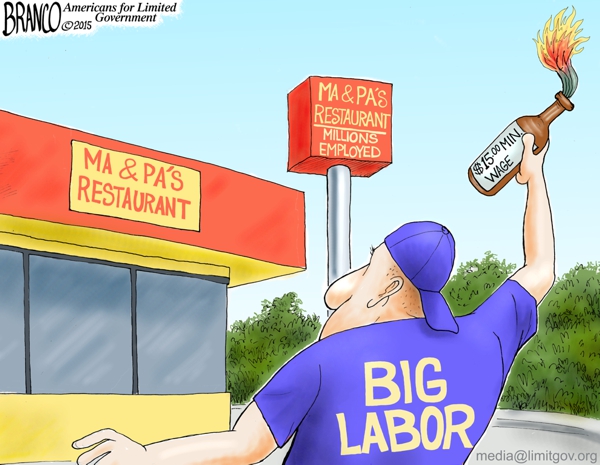By Don Todd
Fast Food Forward, an advocacy organization, makes an eloquent emotional plea for the wellbeing of restaurant workers: “In America, people who work hard should be able to afford basic necessities like groceries, rent, childcare and transportation.” Who can argue with that?
Similarly The Fight for Fifteen organization comes up with this argument, “We Work, We Sweat, Put $15 on Our Check!” How do you argue with that?
As with most emotional arguments they are light on thought. One of the problems with artificially pricing labor by government fiat rather than market forces is that consequences are not as visible to the naked eye as the alleged benefits.
Not that long ago we had service stations in America rather than gas stations. When you pulled in a young person would come to you window and say, “Fill her up?”
As you tank filled the attendant would wash your windows, check the oil and water and tire pressure. Where have those jobs gone? Why have those jobs disappeared?
They have gone to the same place the grocery store carry out boys have gone which is out of existence.
These jobs are generally phased out slowly as labor costs are arbitrarily increased so the impact is not as noticeable as if they disappeared overnight.
According to the National Restaurant Association nearly one third of all Americans got their first job in a restaurant.
- Nearly half were under age 25; this age group accounted for about 20 percent of all hourly paid workers.
- 15 percent of employed teenagers earned minimum wage or less, as compared to about 3 percent of workers over age 25.
- 63 percent were women and 37 percent were men; 5 percent of women earned minimum wage or less, as compared to 3 percent of men.
- 65 percent were part-time workers and 35 percent were full-time workers.
- 11 percent were in the West; 16 percent were in the Northeast; 26 percent were in the Mid-west; 47 percent were in the South.
- 65 percent were in service occupations, with 50 percent in food preparation and serving related occupations.
Eighty-one percent of minimum wage workers do not live in poverty.
As increases in the minimum wage led to self-serve gas stations and carry your own groceries, new increases will inevitably lead to self-serve restaurants. In fact it is already happening.
“Wendy’s said that self-service ordering kiosks will be made available across its 6,000-plus restaurants in the second half of the year as minimum wage hikes and a tight labor market push up wages.
It will be up to franchisees whether to deploy the labor-saving technology, but Wendy’s President Todd Penegor did note that some franchise locations have been raising prices to offset wage hikes.”
These are stepping stone jobs and they are disappearing. They are valuable in that they are normally first time jobs and they teach young adults how to function in the work place and the rules of the road which are much different than the rules in high school or college.
Is it any wonder that the percentage of young adults still living with their parents up to age 35 is the highest on records were first kept in 1880?
“Many of America’s young adults appear to be in no hurry to move out of their old bedrooms.
“For the first time on record, living with parents is now the most common arrangement for people ages 18 to 34, an analysis of census data by the Pew Research Center has found.”
“And the proportion of older millennials — those ages 25 to 34 — who are living at home has reached its highest point (19 percent) on record, Pew analysts said.”
“Nearly one-third of all millennials live with their parents, slightly more than the proportion who live with a spouse or partner. It’s the first time that living at home has outpaced living with a spouse for this age group since such record-keeping began in 1880.”
This is a direct result of the types of initiatives like those pushed by Fight for Fifteen and the Fast Food Forward campaign.
Don Todd is Director of Research at Americans for Limited Government.







